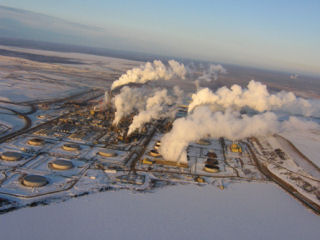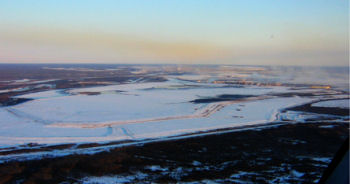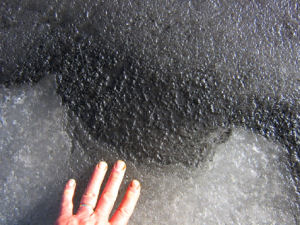Tar sands ‘fingerprint’ seen in rivers and snow
New data counter claims that the pollution was from natural oily seeps
A new study refutes a government claim (one echoed by industry) that the gonzo-scale extraction of tar sands in western Canada — and their processing into crude oil — does not substantially pollute the environment.
Oil reserves in Alberta, Canada, are second only to Saudia Arabia’s in size. Unlike the bubbling crudes pumped to the surface from underground reserves throughout most of the Lower 48 and Mexico, Alberta’s constitute thick, viscous hydrocarbons mixed in with silica. Hence their name: oil or tar sands.
Mined by the shovelful, Alberta’s hydrocarbon-soaked sands are hauled by monster trucks to nearby “upgrading” plants, which refine the tarry bitumen into conventional petroleum.
The Athabasca deposit, Alberta’s largest — and the only one extractable from the surface — has been delivering a million barrels of oil per day since 2006. The Athabasca River slices through this oily deposit as it flows northward.
Both the river and the Lake Athabasca into which it drains have been prime fishing grounds for local native peoples and a host of wildlife. Although these waters bear the taint of petroleum-linked pollutants, the provincial government and tar-sands industry have both claimed hydrocarbon pollution comes from the natural erosion of oily sediment over which the waters flow.
Indeed, the Aug. 30, 2010, Globe and Mail quoted Preston McEachern, head of science and research programs for Alberta Environment, a government agency, as saying: “The erosion of natural sources is huge. It far exceeds anything you’d be able to detect from the industrial component.”
Hogwash, counters David Schindler of the University of Alberta in Edmonton. Well, that’s a paraphrase. What he actually said was “The propaganda put out by industry and the Alberta government is that this huge industry is not polluting the river at all. It’s absolute nonsense — and, of course, that’s the reason we designed our new study.”
Pollution picks up downstream of tar-sands processing
Findings from that study, published Aug. 30 in the Proceedings of the National Academy of Sciences, catalog water concentrations of 13 elements that can poison wildlife or people: arsenic, mercury, copper, chromium, nickel, selenium, beryllium, lead, cadmium, silver, zinc, antimony and thallium. And in nearly every site downstream of tar-sands extraction and processing, concentrations of these hazardous materials were higher — sometimes dramatically so — than in waters upstream of tar-sands development.
In contrast to McEachern’s claim, concentrations of pollutants in water running through the Athabascan tar-sands fields upstream of this industrial activity are at background levels (those seen upstram of tar-sands fields).
Only at disturbed sites where industrial activity is underway did pollution concentrations start to soar. For instance, winter deposition in snow was 30-fold higher downwind of tar-sands activity than at upwind sites. Some summer water concentrations of the toxic metals were 5-fold higher than upstream values.
Overall, Schindler notes, river water values were “still double background levels for most of the elements” as far downstream as Lake Athabasca, at least 150 kilometers to the north of most tar-sands processing.
Refuting the government claims that seeps tainted the rivers, Schindler’s group measured the accumulated fallout of particulates from tar-sands processing over the winter on snow — including atop iced-over rivers and their tributaries. Based on sampling in a 50 km radius around the bitumen-upgrading plants, lead author Erin Kelly and her colleagues calculated a four-month fallout of some 11,400 metric tons of tar-sands-derived particulates. Over the course of the year, that should amount conservatively to 34,000 metric tons of tar-sands pollution, Schindler says (and probably more owing to the higher rates of surface erosion in summer).
The particulate pollution that doesn’t initially fall directly onto flowing water can arrive there in runoff during rains, from the settling out of eroded dust and soil and as snowmelt. The deposition from these sources is what largely accounts for the high concentrations of bitumen-derived metals and other pollutants downstream of tar-sands processing, Schindler says — not Mother Nature’s seeps.
Immediately downstream of tailings ponds, where liquid wastes from tar sands processing are dumped to settle out, winter concentrations of chromium, silver and nickel — along with four other elements known to be increased in oil-sands-processing water — were 8-fold greater than upstream, the new study’s authors say. And that “suggests tailings pond leakage or discharge as source of [these] to the Athabasca River,” they say.
These new data “provide really interesting and useful data, because they link industrial particulates with the same contaminants in the river downstream as far as Lake Athabasca,” notes Kevin Timoney of Treeline Ecological Research in Sherwood Park, Alberta. “That’s important,” he contends, “because now we can say unequivocally that there’s a large and growing contribution from industry of these contaminants to the land and water.”
What makes the data compelling, Timoney says, is that “we have fingerprints” — ratios of the measured pollutants that match what was coming out of industrial stacks, from wind erosion, from the faces of mine pits and from coking dusts emitted at upgrading sites. Those fingerprints vary with the source, he says, allowing researchers to not only rule out underwater seeps as their source but also to apportion what share of bitumen-based pollutants in water came from which activities.
Concerns about toxicity
The elements assayed in the new study were among 31 that Schindler’s group studied. Later papers will describe those and the results of screening for these toxic substances in Athabasca wildlife — including fish and water fowl.
With a few exceptions, Schindler suspects that most of the elements mentioned in this new paper were probably low enough — at least where people live and fish — that they won’t cause serious injury. “But that’s pure speculation,” he adds.
“There are a few contaminants, however, that I do worry about,” he notes — “especially mercury.” In some local waters, even upstream concentrations of mercury have been high enough to trigger fish-consumption advisories, especially for pregnant women. Adding more mercury to the waters “now will potentially make toxic fish more toxic,” Schindler says
Moreover, as the price of oil has risen, so has tar-sands development. Production rates in 2008 were 2.5 times what they were 13 years earlier, Schindler’s group notes. They’re expected to double again within the next decade. So whatever concentrations of pollutants are raining down as dust-like motes of airborne particles will only increase if regulations don’t curb their release.
Concentrations of some of the pollutants already can be toxic enough during certain periods of the year to kill minnow embryos, the new PNAS paper says.This could threaten some fish populations, limiting the food source for predators of affected species.
And Timoney notes that a 2009 analysis found elevated rates of cancer among the 1,200 residents of Fort Chipewyan, a native peoples community on the western shore of Lake Athabasca. Conducted for Health Canada by Yiqun Chen of the provincial cancer board, this analysis turned up rates of malignancies affecting the biliary tract, blood and lymphatic system, soft-tissues, and lung cancers (although here, in women only) that were higher than would have been expected to occur.
Although statistically significant, the apparent risks may be spurious due to the small sample size, Chen acknowledged in her report. However, she added, “Regardless of whether or not there is truly an increased risk of cancer in Fort Chipewyan, one immediate step should be to investigate whether or not cancer patients [there] were exposed to potential causative agents.” News accounts have quoted residents as saying they’re concerned tar-sands activities might be the source of such toxicants.
A 2009 report by Timoney and Peter Lee of Global Forest Watch in Edmonton cited comments from a number of Fort Chipewyan residents about changes they’d witnessed in their environment. The river water tastes differently now — oily, sour, or salty, for instance. Boiling Athabasca River water leaves a brown residue in pots. And fish in the river sport high rates of lesions and deformities. One resident described the fish this way: “Pushed in faces, bulging eyes, humped back, crooked tails . . . never used to see that. Great big lumps on them . . . you poke that it sprays water.”
So what aspects of the tar sands might be responsible? That’s hard to say, Timoney acknowledges. Like cigarette smoke, tar-sands emissions contain hosts of potentially toxic substances that may cause problems alone or in combination. Teasing out which if any are active can take lots of research, something that he says has generally been in short supply when it comes to the Athabasca River environment generally and to tar-sands pollution specifically.
The elements in the latest study all appear on a list of potentially hazardous “priority pollutants” that are regulated under the Clean Water Act by Canada’s neighbor to the south. In Alberta, Schindler says, these toxic metals and other elements are subject only to guidelines that suggest safe upper limits. However, there is a Fisheries Act that prohibits discharges of deleterious substances into fish-bearing waters. “And,” he says, “I would say that at the very least, we have shown that is happening.”
Demonstrating toxic fallout of industrial emissions into local waters could open the way for environmental groups to petition — even sue — Canadian federal agencies to stop releases, Schindler says. In fact, “I am assuming that will now happen.”









